
North Dakota Department of Agriculture. Photo courtesy of NDSU Extension
BISMARCK – Palmer amaranth (Amaranthus palmeri) has been confirmed in Stutsman County. A county weed officer noticed some suspect plants in a field and notified the landowner. The weed officer then worked with North Dakota State University Extension to submit samples for DNA analysis to the National Agricultural Genotyping Center, where it was confirmed as Palmer amaranth.
This is the second finding this year. Palmer amaranth was also found in Benson County earlier this year, and originally in 2018.
Palmer amaranth is native to the southwestern U.S. but was accidentally introduced to other areas and has devastated crops in the South and Midwest. It is a prolific seed producer that can emerge throughout the growing season. It grows rapidly at 2-3 inches per day in optimum conditions and is prone to herbicide resistance and multiple modes of action. It is a highly invasive weed that can dramatically cut crop yields.
“I strongly encourage agricultural producers to monitor fields for weed infestations, especially where manure was spread or where cattle that were fed grain screenings may have foraged,” Agriculture Commissioner Doug Goehring said. “With harvest season in full swing, farmers are also encouraged to scout fields and clean excess dirt and plant debris off equipment between fields to prevent unintentional spread.”
The public is urged to work with local weed officers, extension agents and other experts to identify and report suspect plants. Palmer amaranth may spread through multiple channels, including: contaminated seed mixes; equipment and machinery movement; animal feed and bedding; and wild birds.
Palmer amaranth has now been found in 10 North Dakota counties. Those sites continue to be monitored for Palmer amaranth. More information on Palmer amaranth and other noxious and invasive weeds is available at https://www.nd.gov/ndda/plant-industries/noxious-weeds.
To report a suspect plant, go to https://www.nd.gov/ndda/pa or contact your local county weed officer or North Dakota State University Extension agent.
